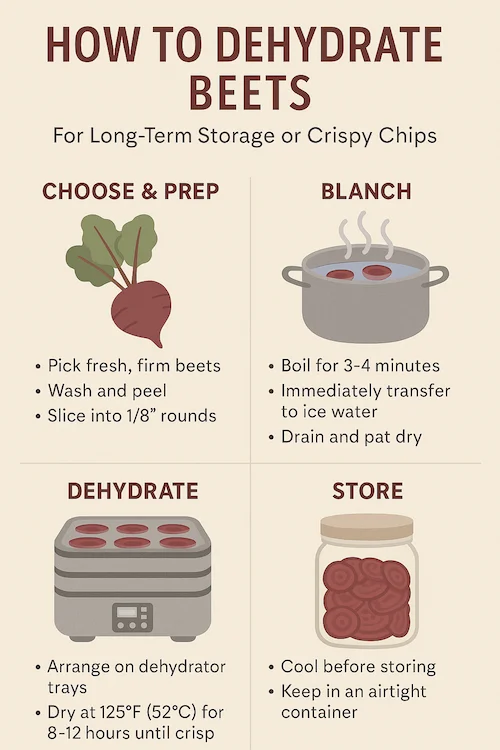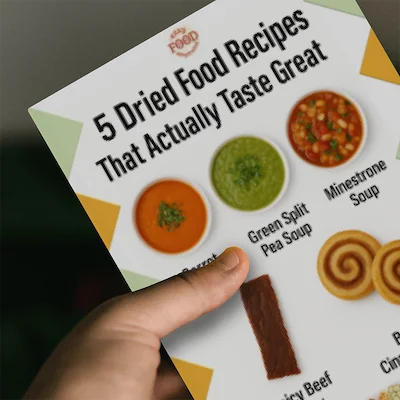What We Mean by “Dehydrate”
Here at Easy Food Dehydrating, “dehydrate” always means using an electric food dehydrator — the easy, reliable way to dry food at home.
- Home
- Dehydrating Vegetables: Step-by-Step Guides by Type
- How to Dehydrate Beets for Powder or Crispy Chips
How to Dehydrate Beets: Make Crispy Chips or Powder

Dehydrating beets is one of the easiest and most rewarding ways to preserve their earthy sweetness and vibrant color. Whether you’re using a dehydrator, oven, or even air-drying, this simple method locks in nutrients and flavor while extending shelf life for months.
✅ Quick Answer: How to dehydrate beets?
- Wash and peel fresh beets, then slice them into thin, even rounds about ⅛ inch thick.
- Blanch for 3–4 minutes to preserve color (optional but recommended).
- Dehydrate at 125°F–135°F for 8–20 hours, until fully crisp and dry.
- Store in airtight Mason jars, or grind dried slices into fine beet powder for smoothies, soups, and natural food coloring.
In this guide, you’ll learn exactly how to dehydrate beets - from preparation and slicing to drying times, storage, and even turning them into bright, nutrient-rich beet powder.
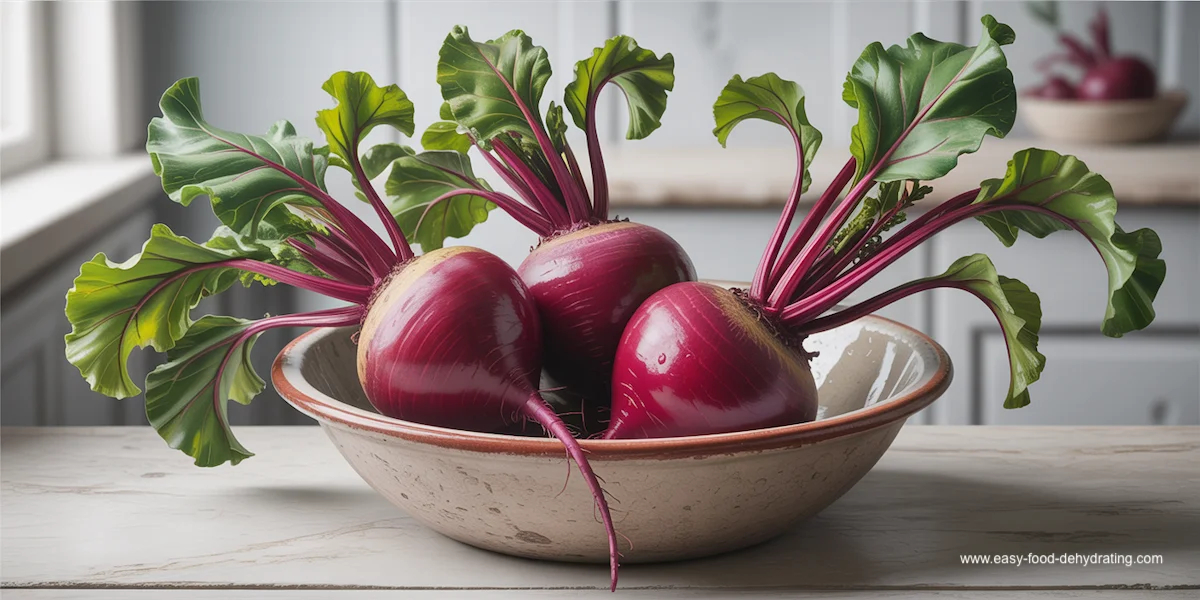
Beet Nutrition: Why These Roots Are So Good for You
VITAMINS: Folate (Vitamin B9), Vitamin C, and Vitamin B6.
MINERALS: An excellent source of Manganese, Potassium, and Iron, along with Magnesium and Copper.
Beets also contain nitrates, which may help lower blood pressure, and betalains, which are considered to contain powerful antioxidants that have anti-inflammatory properties. Beets also contain fiber. We need more fiber, folks!
Should You Blanch Beets Before Drying? Here’s Why
Blanching beets before dehydrating helps preserve their color and reduces dehydrator-drying time. How so? Blanching creates tiny cracks in the skins making it faster and easier to dry. Slicing beets thinly and evenly gives good, consistent results.
When stored properly, dehydrated beets can last for months, making them a great pantry addition in an effort to keep your food pantry full.
Prepping Beets for Dehydration: What You Need to Know
here's how to select the best beets and prepare them for dehydration.
How to Pick the Best Beets for Drying (and Which to Avoid)
When picking beets for dehydration, choose firm, smooth-skinned roots without blemishes. Fresh beets are colorful and have crispy green tops. I prefer medium-sized beets as they’re easier to slice evenly!
Large beets often have woody centers, so I avoid those. If possible, I use organic beets to minimize pesticide exposure. At the store, I gently squeeze each beet – it should feel solid with no soft spots.
To prepare beets for my food dehydrator, I start off by washing them thoroughly and scrubbing off any dirt with a vegetable brush, or a finger-nail cleaning brush.
Step-by-Step Guide: How to Dehydrate Beets at Home
Special Note: When to Steam or Pre-Cook Beets Before Drying
Trim off the tops and roots, leaving about an inch of stem to prevent color bleeding. What's that, you ask? It's when beets are raw, their colorful pigments can leak out so leaving a bit of the stem in place kind of keeps it sealed.
Also, keep a tad of the taproot in place. This ONLY applies if you're going to steam, or pre-cook the beets before drying. If you're drying your beets raw, then slice away as you would a potato. There is no need to keep a part of the stem or part of the taproot at the bottom.
Prepping Slices for Perfect Drying Results
Next, peel the beets using a vegetable peeler. For even drying, I slice them into 1/8-inch thick rounds using a mandoline or a sharp knife. (Amazon Affiliate link, thanks). Consistency in thickness is key for uniform dehydration so all the slices dry at the same rate.
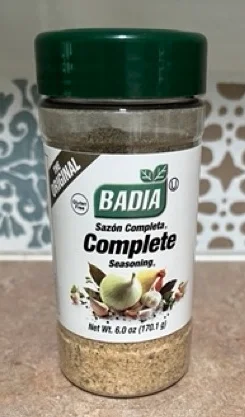
Before loading my dehydrator trays, I blanch the beet slices in boiling water for 3-4 minutes. This helps preserve color and texture. After blanching, I immediately plunge them into ice water to stop the cooking process.
IF you wish to season your chips with salt or your favorite seasoning - do it now.
I love Badia Complete which I put in just about every savory dish I make. It's readily available at your local supermarket. And probably Amazon has it. They have everything... right?
How to Dehydrate Beets in a Food Dehydrator
- Prep as described above.
- Season as desired.
- Arrange them on your dehydrator trays, trying not to overlap the pieces.
- Turn on your food dehydrator and set the temperature between 125°F and 135°F (or per your food dehydrator's instructions).
- Fully dehydrated beets will be crisp and brittle when fully dried.
- Drying time: between 16-20 hours.
- Please remember to rotate your dehydrator trays, for even drying.
Can You Dehydrate Beets in the Oven? Yes—Here’s How
- Preheat oven to 275°F.
- Brush slices with olive oil and sprinkle with salt, as desired.
- Arrange on a baking sheet lined with parchment paper without overlapping the slices) for 1-1/2 to 2 hours. Note: Flip 'em over at the one-hour mark.
Beets are "done" when they're dry and crispy, with no moisture left.
Air Fryer Beet Chips: Quick but Tricky
- Slice the beets thinly, same as the other methods: 1/8" thick.
- Toss slices with olive oil, and salt - if desired.
- Preheat air fryer to 320°F
- Arrange the slices in a SINGLE layer. Don't overcrowd.
- COOK the chips for 15 to 20 minutes, shaking the air fryer basket every five minutes.
NOTE: This method is more for cooking than for dehydrating, IMHO. And keep an eye on them as you near the 20-minute mark as they can burn quickly in an air fryer.
Allow them to completely cool down so they'll crisp up even more!
💡 Tip: Outside the U.S.? Most dehydrating temps here are listed in Fahrenheit - use our quick converter to see the Celsius equivalent for your machine.
Which Beet Varieties Work Best for Dehydrating?
I always thought there was only one kind of beet, color-wise. I'm so used to buying canned pickled beets which I use in salads.
But I discovered at least six varieties:
- Red Beets (Deep Red): The most common variety is a deep red or purple color with a sweet, earthy flavor AND are the ones most often pickled.
- Golden Beets: They are a bright yellow-orange color and have a milder, less earthy flavor than red beets. They're a little sweeter and less "beety" tasting.
- Chioggia Beets (Candy Cane Beets): They have a pink exterior with white and pink rings inside! They have a mild flavor and are slightly sweeter than red beets. Look how gorgeous they are sliced!
- White Beets: White or off-white in color. They are sweeter and less earthy than red beets. Use these in salads or for pickling.
- Cylindra Beets: Elongated shape (rather like a carrot). They are deep red in color and are good for slicing and canning.
- Baby Beets: Any variety harvested young - typically sweeter and more tender.
Each of these varieties can be used when dehydrating beets. Obviously, you'll get a color and subtle flavor difference with each. Golden beets are milder-tasting, while Chioggia beets make visually striking chips with their ring pattern - see the image below, courtesy of rareseeds.com.
Creative Ways to Use Beet Powder in Meals and More
I’ve found that beet powder is a super way to add extra nutrition to my meals. I've even sprinkled a dash of it into my morning smoothies for a color - and a nutritional boost.
Beet powder works great in:
- Smoothies
- Soups and stews
- Baked goods
- Homemade energy bars
Linda M via Facebook says:
"I’ve even experimented with using beet powder as a natural food coloring in frostings and as a base for homemade makeup like blush and lip gloss. It’s a fun and healthy way to add some color to my life!"
Infographic: Your Quick Guide to Dehydrating Beets
Want the quick version? This visual guide walks you through how to prep, blanch, dry, and store beets—whether you're making chips or stocking your pantry.
📌 Add this to your Pinterest board
Homemade Beet Chips Recipe: Crispy and Addictive
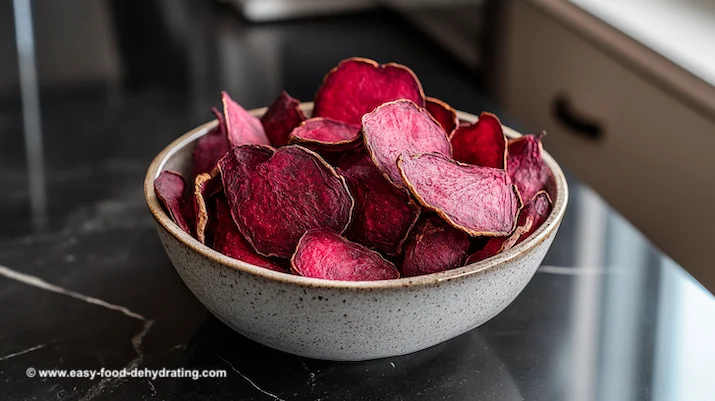
Ingredients:
- 2-3 medium-sized beets
- 1 tablespoon olive oil (optional)
- 1/2 teaspoon salt
- 1/4 teaspoon black pepper
- Optional seasonings: garlic powder, onion powder, or your favorite herb blend
Instructions:
- Wash and scrub the beets thoroughly.
- Peel the beets if desired (peeling is optional but can result in a more uniform texture).
- Slice the beets very thinly (about 1/8 inch thick) using a mandoline or sharp knife.
- In a large bowl, toss the beet slices with olive oil (if using), salt, pepper, and any additional seasonings.
- Arrange the beet slices in a single layer on dehydrator trays, making sure they don't overlap.
- Dehydrate at 125°F (52°C) for 8-12 hours, or until the chips are crispy and dry.
- Check the chips periodically and rotate trays if your dehydrator doesn't have a good air-circulating fan.
- Once fully dried and crispy, remove from the dehydrator and let cool completely.
- Store in an airtight container.
Best Ways to Store and Rehydrate Your Dried Beets
Store your dried beets in vacuum-sealer bags or Mason jars with an oxygen absorber before sealing. Easy, airtight, and pantry-ready.
To rehydrate, just soak them in cool, clean water for 15–30 minutes—hot water works too, but I’m not a fan of soaking stuff in warm water (hello, germs).
They bounce back close to their original flavor and texture. Toss 'em straight into soups or stews and they’ll rehydrate as they cook. Just add a splash more liquid. Easy peasy.
Your Top Questions About Dehydrating Beets, Answered
Do I need to peel beets before dehydrating?
Do I need to peel beets before dehydrating?
Peeling is optional, but recommended if you want smooth, evenly textured chips or powder. Leave skins on if you scrub them well.
How long do dehydrated beets last?
How long do dehydrated beets last?
Properly dried beets stored in airtight jars with oxygen absorbers and desiccant packets last 12–18 months in a cool, dark place.
Can I dehydrate beets raw without blanching?
Can I dehydrate beets raw without blanching?
Yes. Raw slices can be dehydrated directly, but blanching first helps preserve color and reduce drying time.
What’s the best way to make beet powder?
What’s the best way to make beet powder?
Once slices are crisp and cool, grind them in a high-speed blender or spice grinder until fine. Store the powder in airtight jars.
Are dehydrated beet chips as healthy as fresh beets?
Are dehydrated beet chips as healthy as fresh beets?
Yes - they retain most vitamins, minerals, and fiber, making them a nutrient-dense, low-calorie snack.
Now you know how to dehydrate beets into crisp chips, vibrant powders, or pantry-ready slices for soups and stews.
If you’d like even more easy and tasty ideas, don’t miss my free 5 Dried Food Recipes You’ll Actually Love PDF. Inside you’ll find carrot soup, minestrone, split pea soup, spicy beef jerky, and even banana cinnamon rolls — all proven favorites that make dehydrating fun and delicious!
Get 5 Dried Food Recipes You'll Actually Love
Here's where you can get your copy of our all new
5 Dried Food Recipes (That Actually Taste Great)
They're my all-time favorite easy dried food meals!
Get it here right now.
For Free!
Before You Go...
If you enjoyed this page, tap the ❤️ in the lower right-hand corner.
It saves this page to your Grow bookmarks so you can find it again later.
You’ll also see quick share buttons to copy the link, post to Facebook,
or save it straight to Pinterest.

